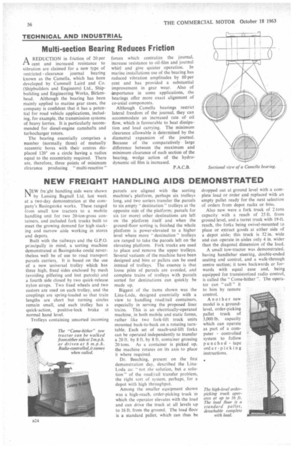NEW FREIGHT HANDLING AIDS DEMONSTRATED
Page 58

If you've noticed an error in this article please click here to report it so we can fix it.
NEW fre:ght handling aids were shown by Lansing Bagnall Ltd. last week at a two-day demonstration at the company's Basingstoke works. These ranged from small tow tractors to a mobile handling unit for two 20-ton-gross containers, and included fork trucks built to meet the growing demand for high stacking and narrow aisle working in stores and depots.
Built with the railways and the G.P.O. principally in mind, a sorting machine demonstrated at Basingstoke could nevertheless well be of use to road transport parcels carriers. It is based on the use of a new universal trolley which has three high, fixed sides enclosed by. mesh (avoiding pilfering and lost parcels) and a fourth side closed by two quick-release nylon strops. Two fixed wheels and two castors are used on each trolley, and the couplings are spring-loaded so that train lengths are short but turning circles remain small, and each trolley has a quick-action, positive-lock brake at normal hand level.
Trolleys containing unsorted incoming
parcels are aligned with the sorting machine's platform, perhaps six trolleys long, and two sorters transfer the parcels to six empty " destination " trolleys at the opposite side of the platform; parcels for six (or more) other destinations are left on the platform itself and when the ground-floor sorting is finished the whole platform is power-elevated to a higher level where more " destination " trolleys are ranged to take the parcels left on the elevating platform. Fork trucks are used to place and remove the upper trolleys. Several variants of the machine have been designed and bins or pallets can be used instead of trolleys. The essence is that loose piles of parcels are avoided, and complete trains of trolleys with parcels sorted for destinations can quickly be made up.
Biggest of the items shown was the Lina-Loda, designed essentially with a view to handling road/rail containers. especially in serving the proposed liner trains. This is an electrically-operated machine, in both mobile and static forms, rather like two fork-lift truck units mounted back-to-back on a rotating turntable. Each set of reach-and-lift forks can be operated independently to transfer a 20 ft. by 8 ft. by 8 ft. container grossing 20 tons. As a container is picked up, the machine rotates on its axis to place it where required.
Dr. Beeching, present on the first demonstration day, described the LinaLoda as: "not the solution, but a solution" of the road/rail transfer problem, the right sort of system, perhaps, for a depot with high throughput.
Among the smaller equipment shown was a high-reach, order-picking truck in which the operator elevates with the load and can drive the truck at all levels up to 16 ft. from the ground. The load floor is a standard pallet, which can thus be dropped out at ground level with a complete load or order and replaced with an empty pallet ready for the next selection of orders from depot racks or bins.
Also new were a fork truck of 2 tons capacity with a reach of 25 ft. from ground level, and a turret truck with 19-ft. reach, the forks being swivel-mounted to place or extract goods at either side of a depot aisle; this truck is 52 in. wide and can operate in aisles only 4 in. wider than the diagonal dimension of the load.
A small tow-tractor was demonstrated, having handlebar steering, double-ended seating and control, and a walk-through centre section; it tows backwards or forwards with equal ease and, being equipped for transistorized radio control, is called the "Come-hither ". The operator can "call " it to him by remote control.
Another new model is a groundlevel, order-picking pallet truck of 3,000 lb. capacity which can operate as part of a computer controlled system to follow punched tape order-picking instructions.




































































































































